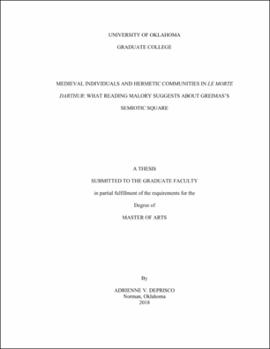| dc.description.abstract | In Sir Thomas Malory’s Le Morte Darthur, the progression of the Round Table toward its ultimate destruction offers examples of how the medieval individual navigates through various communities, as well as the fracturing (both of self and system) that occurs when this navigation is forbidden. The medieval conception of the individual is not a man within a vacuum but is instead he who emerges through the participation in and balancing of membership in many groups. Arthur, however, has created a hermetic community that does not allow access to other groups, which in turn stunts the development of the very knights on which he and his system rely. Their inability to grow into individuals, paired with growing tensions between the knights, causes the ultimate destruction of Arthur’s community.
Furthermore, the Round Table in many ways seems like a trespass into the space that one might expect to be filled by the Church. Malory is a notably secular writer for his time; he focuses more on physical prowess and worldly reward over spiritual growth. That being said, Arthur’s community does not merely ignore the institution of the Church—it seems instead to try to replace it. Arthur sets himself up as the moral compass for his knights, his system requires that knights internalize the goals of the Round Table, and when religion does fill a presence in Camelot through the Grail Quest, the vast majority of knights are too steeped in sin to be successful in their pursuit of the spiritual. Indeed, Arthur appears to use the Church (as a physical institution) as a model for his project but does not also adopt the attributes of the Church as a spiritual body. In short, by his very design the king’s community is frozen in space and time, and it lacks those transcendent attributes that would allow it (similar to the Church) to adapt and survive. This is best revealed by Arthur’s unwillingness—or inability—to accept his knights as multifaceted members of multiple groups, which makes their development into medieval individuals impossible, and makes his community unsustainable.
To better frame and explore these points, I use Greimas’s semiotic square as a model for inquiry. Analyzing the various components of Malory’s story as four corners on a square helps the reader to see how each component interacts and contrasts with the others. Indeed, the square makes for a clear and logical foundation upon which to begin one’s inquiry; it is where I began mine. Through my analysis of Le Morte Darthur, however, I will illustrate what Malory offers to challenge the square, as well as what I conclude would be a better tool for structural analysis. While the semiotic square helps to clearly establish a framework through which to understand a text, it does not communicate the evolution and fluidity within the narrative. Malory’s story, through its dynamic content and structure, suggests a need for a new tool and even offers a sense of what that tool could look like. | en_US |
